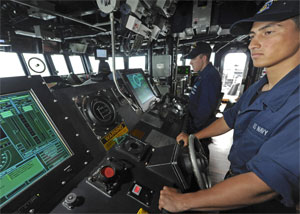In the wake of high-profile collisions involving U.S. Navy destroyers, including a 2017 incident that killed 10 sailors aboard USS John S. McCain, the service is revising bridge training practices and addressing what it sees as an over-reliance on computer touch screens for ship control.
The investigation into the August 2017 collision and one involving another Arleigh Burke-class destroyer, USS Fitzgerald, showed that the touch-screen systems were complex and that sailors had been poorly trained to use them. As a result, the Navy said it plans to begin retrofitting destroyers in the class with traditional mechanical throttles.
The sequence of events has had significant repercussions, as other military branches and even civilian operators may examine their practices and consider whether they might be vulnerable to the same accidents that befell the Navy.
Douglas Crowder, retired from the Navy and now the president of a consulting firm, served as commander of the 7th Fleet and Navy Destroyer Squadron 24. He said his interpretation of the Navy’s findings is that the incidents were mostly a result of “training issues” and poor decision-making by the commanding officers.
“You need to bring up the best of everything to navigate in one of the busiest shipping areas in the world,” Crowder said in reference to McCain’s collision with a Liberian tanker in the Strait of Malacca. Some of the sailors on McCain’s bridge had recently transferred from other vessels and had a poor understanding of systems and procedures on the ship, he said.
Chief Warrant Officer Kurt Fredrickson, a spokesman for the U.S. Coast Guard, said the lessons learned by the Navy in the McCain incident are applicable to all professional mariners. Similar issues were cited after Fitzgerald collided with a Philippine containership off Japan in June 2017, killing seven U.S. sailors.
“The Coast Guard incorporated discussions on the McCain and Fitzgerald mishaps into its training curriculum, and modified bridge simulator scenarios to (include) environmental and navigational elements similar to those experienced at the time of these unfortunate mishaps,” Fredrickson said. “The Coast Guard has and will continue to adapt its navigation practices when warranted by operational lessons learned, in the wake of technological advancements, or when traditional navigation methods are rendered obsolete.”
On the civilian side, Margaret Ward, an assistant professor at the California State University Maritime Academy, said merchant mariners typically have logged more sea time than Navy sailors at comparable levels in their careers. Adjusting to a new ship and its systems on the fly is something common to merchant mariners, she said.
“Many mariners may find themselves joining a new ship within hours of it getting underway,” she said. “(But) if there is a failure in a system controlled by new technology that a mariner lacks experience in, it can without a doubt lead to a loss of situational awareness or the first step in an error chain, leading to an incident.”
“Though fire and abandon-ship drills are common to us all, many ships lack frequent, well-rounded training procedures on other emergency scenarios, such as the (actions) a watch stander should take in the event of a steering casualty,” Ward said. “As the use of new technology on board ships becomes increasingly prevalent, it is essential that proper training in its usage comes along with it — especially when that technology governs such essential aspects of a ship’s operation such as steering, propulsion and navigation.”
“I can say one thing for sure,” said Capt. Sam Pecota, director of simulation at Cal Maritime. “We have a couple of full-mission simulators here, with the option of using tactile hardware controls or screens, and the computer screens just don’t give you the same kind of input and feel for steering and controlling the vessel. A real wheel and throttle have more of a feel of the vessel than just moving a mouse.”
For either a civilian or military vessel, Crowder said he would have “no problem training a crew to work with touch screens, but there has to be backup if you lose power or the computer gets squirrelly.”
“I worry that young officers get mesmerized by systems like GPS, and my warning to them is to look out the damn window once in a while,” he added.

